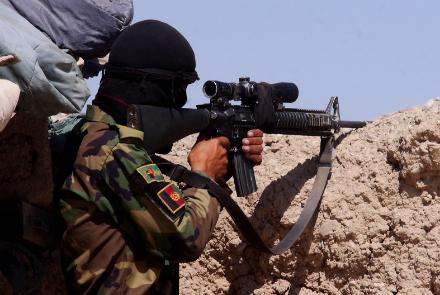One Side—Not Both—is Increasing Violence in Afghanistan: Op-Ed

The US-Taliban agreement in February 2020 created hope for a reduction in violence in Afghanistan. However, since then, violence has instead intensified across the country. The American officials have said that the increase in the level of violence goes against the spirit of the US-Taliban agreement. The agreement does not ask the Taliban to reduce violence but US officials maintain that the Taliban made a verbal commitment to do so. The agreement also calls for the Taliban to halt all attacks against “US and allies,” which should include Afghanistan. Meanwhile, a false narrative is gaining traction that “both sides are increasing violence to gain leverage in the negotiations.” But is this narrative really true? Is the Afghan government increasing violence and does it have the capacity to do so?
First, since February 2018, the Afghan government has offered to negotiate a ceasefire and to recognize the Taliban as a political party. The terms of the offer even said the Taliban could open a political office in Kabul. Since June of 2019, there have been three Eid ceasefires, the first of which was a unilateral eight-day ceasefire initiated by the Afghan government. The second and third Eid ceasefires were announced by the Taliban in May and July 2020. Each time, the Afghan government said it was willing to extend the ceasefire, but the Taliban refused. During the US-Taliban talks, Afghanistan advocated for a ceasefire which to its credit the US tried but was unable to convince the Taliban. Now, with the intra-Afghan talks underway in Doha, the Kabul delegation’s priority is still to secure a ceasefire.
Second, for several reasons, such as pressure by the international community for peace and a great number of Afghanistan National Defense and Security Forces (ANDSF) casualties, Afghanistan is not in a position to increase violence. Afghanistan Analyst Network (ANN) notes that since February, the ANDSF has maintained an “active defensive posture.” In March and April, the Taliban launched an average of 55 attacks across 34 provinces per day. In October, in 24 hours, the Taliban launched attacks in 24 provinces against the ANDSF. An attempt to capture Lashkargah, Helmand’s capital, left some 30,000 internally displaced people. Kate Clark of the AAN concludes that Taliban suicide attacks and the US aerial bombings have dropped, but “neither the US-Taliban agreement nor the start of intra-Afghan talks has brought about a reduction in Taliban attacks, only US and ANDSF attacks.” This corresponds with the Afghanistan Study Group’s conclusion that “the Taliban has instigated most of the recent violence.”
Third, the Taliban remains responsible for more deaths of Afghan civilians. According to the United Nations Assistance Mission in Afghanistan (UNAMA), in the first nine months of 2020, at least 1,021 civilians died and 1,622 were injured. The report attributed 45% of the casualties to the Taliban; 23% to ANDSF; 14% to cross-fighting; 2% to the international forces; 7% to the Islamic State; 7% to other anti-government elements; and 2% to pro-government elements. Meanwhile, assassinations and magnetic bomb attacks across the country are increasing. One bomb attack in Kabul killed former TOLOnews TV presenter Mr. Yama Siawash and two of his colleagues. Another attack in Helmand killed prominent journalist Mr. Elyas Dayee. In Bamyan, one of the safest provinces in Afghanistan, two bomb blasts killed 17 and injured 50. The Taliban has taken responsibility for some of these attacks but not all.
Fourth, the government may not have the capacity to increase violence. Despite the ANDSF carrying out 90% of the operations, when pressed by the Taliban, the international forces had to intervene with air support. The government is also allegedly arming local militias in an attempt to prepare for the worst. Insecurity in the north has pushed actors like Marshal Abdul Rashid Dostum and former governor Atta Mohammad Noor to go to their constituencies. Both have said that while they prefer peace, they are also ready to cooperate with the government in fighting the Taliban. Yunus Qanooni, another northern player, has said that the government should use the “reserve forces” of the former resistance front. At this stage, these schemes seem to be preparing for the worst-case scenario, that is if the Taliban tries to win by force.
Fifth, the high level of violence has negatively impacted people’s perspective about the government while it kept the momentum alive for the Taliban. The government’s approval rating is plummeting due to corruption and bad governance already and violence adds another layer of mistrust. Many Afghans are angry at the government for its failure to protect citizens, particularly against numerous “sticky bombs” and mortar attacks on major cities in broad daylight. These scenes that resemble the 1990s when the mujahedeen groups were closing in on Kabul to overthrow the then “Kabul administration” bring bad memories to many Afghans. By increasing violence, the Taliban has little to lose. The bloodshed remains the glue that keeps the group’s hardliners united until their goal can be achieved.
Therefore, putting the Afghan government on an equal footing with the Taliban when it comes to increasing violence is debatable. The argument of “both sides” overshadows the reality that the Taliban overwhelmingly is responsible for perpetuating violence across the country as their main leverage. At best, the Afghan government has been in a defensive mode while the Taliban actively on offense by consistent attacks on Afghanistan security and civilian targets to push for concessions in the talks. Also, the Taliban has repeatedly rejected calls for a ceasefire. Unless the Afghan government goes full-scale offensive during the negotiations—which is unlikely–the theory of “both sides are increasing violence to gain leverage at the negotiation table” remains invalid.
